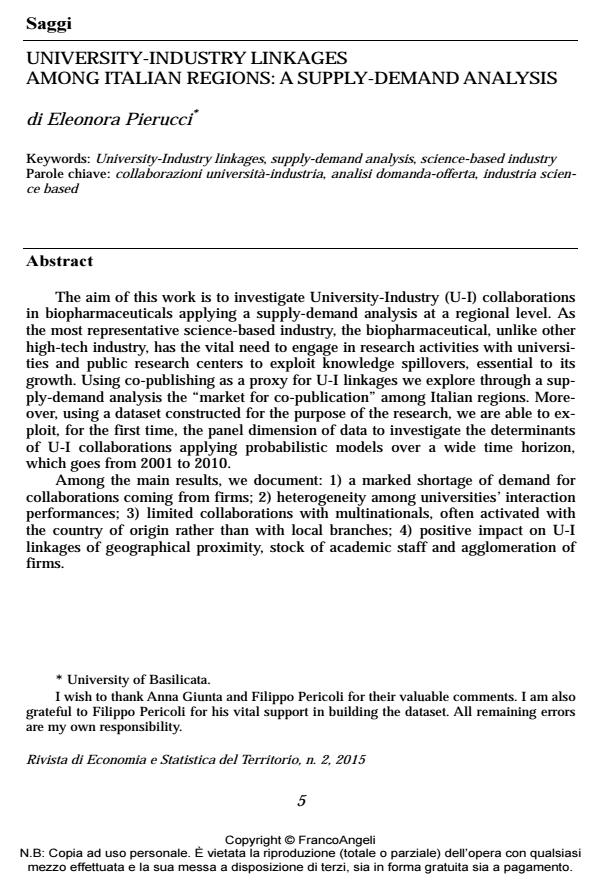University-industry linkages. Among italian regions: a supply-demand analysis
Titolo Rivista RIVISTA DI ECONOMIA E STATISTICA DEL TERRITORIO
Autori/Curatori Eleonora Pierucci
Anno di pubblicazione 2015 Fascicolo 2015/2
Lingua Inglese Numero pagine 29 P. 5-33 Dimensione file 232 KB
DOI 10.3280/REST2015-002001
Il DOI è il codice a barre della proprietà intellettuale: per saperne di più
clicca qui
Qui sotto puoi vedere in anteprima la prima pagina di questo articolo.
Se questo articolo ti interessa, lo puoi acquistare (e scaricare in formato pdf) seguendo le facili indicazioni per acquistare il download credit. Acquista Download Credits per scaricare questo Articolo in formato PDF

FrancoAngeli è membro della Publishers International Linking Association, Inc (PILA)associazione indipendente e non profit per facilitare (attraverso i servizi tecnologici implementati da CrossRef.org) l’accesso degli studiosi ai contenuti digitali nelle pubblicazioni professionali e scientifiche
The aim of this work is to investigate University-Industry (U-I) collaborations in biopharmaceuticals applying a supply-demand analysis at a regional level. As the most representative science-based industry, the biopharmaceutical, unlike other high-tech industry, has the vital need to engage in research activities with universities and public research centers to exploit knowledge spillovers, essential to its growth. Using co-publishing as a proxy for U-I linkages we explore through a supply- demand analysis the "market for co-publication" among Italian regions. Moreover, using a dataset constructed for the purpose of the research, we are able to exploit, for the first time, the panel dimension of data to investigate the determinants of U-I collaborations applying probabilistic models over a wide time horizon, which goes from 2001 to 2010. Among the main results, we document: 1) a marked shortage of demand for collaborations coming from firms; 2) heterogeneity among universities’ interaction performances; 3) limited collaborations with multinationals, often activated with the country of origin rather than with local branches; 4) positive impact on U-I linkages of geographical proximity, stock of academic staff and agglomeration of firms
Il presente lavoro si propone di indagare le collaborazioni tra università e industria biofarmaceutica tramite un’analisi domanda-offerta a livello regionale. La biofarmaceutica è la più rappresentativa industria science-based per la quale, a differenza di altre industre ad alta intensità di tecnologia, lo sfruttamento degli spillovers di conoscenza provenienti dalle università è un requisito essenziale per la sua crescita e profittabilità.<br> Metodi e risultati<br> Utilizzando le co-pubblicazioni come proxy di collaborazione, si analizzerà il fenomeno dei legami tra università e industria tramite l’analisi della domanda e dell’offerta di collaborazioni di ricerca utilizzando una base di dati costruita per i fini della presente ricerca, la quale consente di condurre l’analisi su un arco temporale particolarmente ampio che va dal 2001 al 2010. Pertanto, sarà possibile sfruttare sia la dimensione sezionale sia longitudinale dei dati per la seconda delle analisi condotte, che è quella relativa alle determinanti delle collaborazioni tramite modelli probabilistici. Tra i risultati più rilevanti si registrano: 1) una mancanza di domanda di collaborazioni di ricerca provenienti dalle imprese; 2) marcata eterogeneità tra le performance di interazione tra le diverse università presenti nel panorama italiano; 3) limitate collaborazioni con le multinazionali, spesso attivate con la sede di origine piuttosto che con le sedi locali; 4) impatto positivo della prossimità geografica, dello stock di personale dedicato alla ricerca e della concentrazione di imprese.<br> Conclusioni<br> La biofarmaceutica è un settore strategico per l’Italia in quanto rappresenta il 49% delle esportazioni italiane ad alta tecnologia. Il 90% della ricerca nel settore è finanziata dai privati ed è popolato principalmente da grandi multinazionali. Alla luce dell’analisi condotta, l’Italia appare come un luogo di attrazione per le multinazionali principalmente per la presenza di lavoro qualificato a basso costo. Pertanto, la crescente migrazione di imprese del comparto verso altri Paesi europei desta particolare preoccupazione. Infatti, l’interazione sul piano della ricerca tra università italiane e industria appare limitata e spesso si concretizza con i Paesi di origine delle multinazionali piuttosto che con le sedi locali configurandosi per l’Italia solamente una funzione di luogo di delocalizzazione della produzione piuttosto che di terreno fertile per produzione, ricerca e commercializzazione. In questo scenario, l’Italia dovrebbe tentare di invertire tale tendenza cercando strategie volte a incentivare il coinvolgimento dell’industria nelle attività della ricerca pubblica.
Jel codes:O310, O320, O330, R100
Eleonora Pierucci, University-industry linkages. Among italian regions: a supply-demand analysis in "RIVISTA DI ECONOMIA E STATISTICA DEL TERRITORIO" 2/2015, pp 5-33, DOI: 10.3280/REST2015-002001